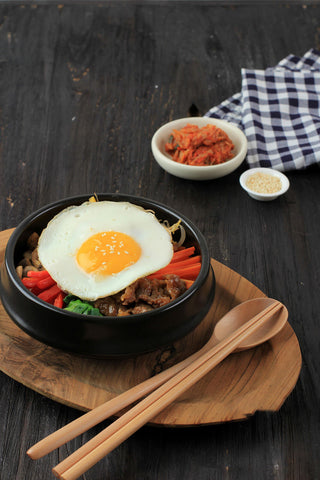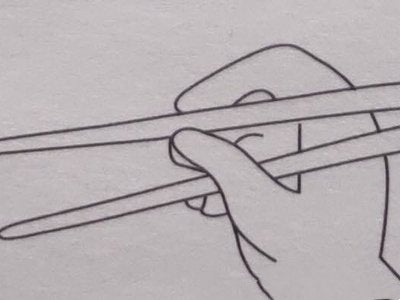
Choose the Right Chopsticks:
To eat bibimbap with chopsticks successfully, it's crucial to select the right utensils. Opt for a pair of well-balanced, medium-length chopsticks that are comfortable to hold and maneuver. Wooden or bamboo chopsticks with textured tips provide a better grip on the ingredients, preventing them from slipping.

Prepare Your Bibimbap:
Before you start eating, it's important to ensure your bibimbap is well mixed. Using a spoon, gently stir all the ingredients, including the rice, vegetables, meat, and sauce, until they are evenly distributed. This step is crucial as it allows the flavors to meld together, ensuring each bite is a delightful fusion of tastes.
Hold the Chopsticks Properly:
To eat bibimbap with chopsticks, hold one chopstick between your thumb and index finger as you would hold a pen. Place the other chopstick on top and grip it with your middle finger. Adjust the position of the chopsticks to find a comfortable and stable grip.

Start with a Small Portion:
To avoid overwhelming yourself and making a mess, start by picking up a small portion of the bibimbap. Aim to gather a balanced mix of rice, vegetables, and protein. Avoid biting off more than you can chew as it can make it difficult to handle the chopsticks and result in a messy dining experience.
Use the Chopsticks as Tongs:
When eating bibimbap, think of your chopsticks as an extension of your fingers. Instead of using them to stab or pierce the ingredients, use them as tongs to pick up a manageable bite. Gently squeeze the chopsticks together, holding the ingredients securely but without applying too much pressure.

Lift and Rotate:
With your chopsticks securely holding the bite-sized portion, lift it from the bowl and rotate it to ensure you have a balanced combination of ingredients in each bite. This rotating motion allows you to gather rice, vegetables, meat, and sauce in one cohesive mouthful, maximizing the flavor profile of the dish.
Control Your Chopstick Angle:
As you bring the loaded chopsticks towards your mouth, control the angle of the chopsticks to avoid spills and maintain control over the bite. Tilt the chopsticks slightly downward, positioning them parallel to your mouth. This ensures a smoother transition from chopsticks to your mouth, minimizing any chances of dropping the ingredients.
Savor and Repeat:
Once you have successfully transferred the bite-sized portion to your mouth, take a moment to appreciate the flavors and textures of the bibimbap. Chew slowly, allowing the ingredients to mingle on your palate, and relish the harmonious blend of flavors. Repeat the process, gradually savoring the dish bite by bite until your bibimbap is thoroughly enjoyed.
Take Your Time:
Eating bibimbap with chopsticks requires a certain level of dexterity and finesse. It's essential to take your time and enjoy the process rather than rushing through the meal. Practice makes perfect, so don't be discouraged if you find it challenging initially.

